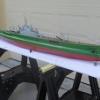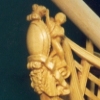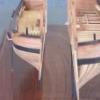-
Posts
13,092 -
Joined
-
Last visited
Reputation Activity
-
 druxey got a reaction from Canute in Sitzbank aus Eisen (Bench made of iron)
druxey got a reaction from Canute in Sitzbank aus Eisen (Bench made of iron)
Thank you, translators! Viele danken!
-
 druxey got a reaction from michael mott in HMS Terror by Erebus and Terror - FINISHED - Scale 1:48 - POB - as fitted for polar service in 1845
druxey got a reaction from michael mott in HMS Terror by Erebus and Terror - FINISHED - Scale 1:48 - POB - as fitted for polar service in 1845
That metalwork was really labour-intensive! Lovely result, even if the pawl rim detail is mostly hidden.
Your (b)log is very nicely presented as well, E&T. Good stuff!
-
 druxey got a reaction from Piet in Young America 1853 by EdT - FINISHED - 1:96 - POB - extreme clipper
druxey got a reaction from Piet in Young America 1853 by EdT - FINISHED - 1:96 - POB - extreme clipper
Going into the era of composite ships, there was often a mix of old and (then) new technology. For instance, Cutty Sark has iron frames, wooden hull and riveted iron bulwarks. So is it not possible, at the time of the photographs in question, that iron bulwarks had replaced original wooden ones?
-
 druxey got a reaction from EdT in Young America 1853 by EdT - FINISHED - 1:96 - POB - extreme clipper
druxey got a reaction from EdT in Young America 1853 by EdT - FINISHED - 1:96 - POB - extreme clipper
Going into the era of composite ships, there was often a mix of old and (then) new technology. For instance, Cutty Sark has iron frames, wooden hull and riveted iron bulwarks. So is it not possible, at the time of the photographs in question, that iron bulwarks had replaced original wooden ones?
-
 druxey got a reaction from mtaylor in HMS Terror by Erebus and Terror - FINISHED - Scale 1:48 - POB - as fitted for polar service in 1845
druxey got a reaction from mtaylor in HMS Terror by Erebus and Terror - FINISHED - Scale 1:48 - POB - as fitted for polar service in 1845
That metalwork was really labour-intensive! Lovely result, even if the pawl rim detail is mostly hidden.
Your (b)log is very nicely presented as well, E&T. Good stuff!
-
 druxey reacted to Erebus and Terror in HMS Terror by Erebus and Terror - FINISHED - Scale 1:48 - POB - as fitted for polar service in 1845
druxey reacted to Erebus and Terror in HMS Terror by Erebus and Terror - FINISHED - Scale 1:48 - POB - as fitted for polar service in 1845
CAPTAIN PHILLIPS’ PATENT CAPSTAN
To this point, my build log has included detailed notes about my research into Franklin's ships, and is largely a mirror of my blog, Building HMS Terror. While I know some followers have enjoyed my research notes (thanks for all the kind words of encouragement), others find them tedious, and recreating them here every time I finish a part has become quite time consuming.
For the remainder of my build log, I've decided to do something a little different, and keep this primarily as a photo essay of my build. I'll continue to post research notes, but those will only appear on my blog. This change will also allow me to post a few more photos here, for those who want to see more wood and metal.
So, with that formality out of the way, here is my attempt to build plans and a model of an 1839 era improved capstan. For those interested in the historical research I conducted, please consult my blog!
An 1839 era Phillips, capstan, as I believe it may have been
configured for use on HMS Erebus and Terror.
Cutting the capstan components on an Epilogue laser cutter.
The completed pieces.
Vellum was added to enhance the joints of the capstan.
The assembled capstan before sanding.
Sanded to shape.
Drilling the bolt locations.
The completed drumhead. Some Phillips' capstan models
show lined sockets, so I added boxwood liners.
I admit that it was primarily an aesthetic choice.
I cut the drumhead plate from an unused pipe fitting which I flared to the right size.
I filed a lip into the plate by hand.
I cut the pawl rim (ring) out of brass plate using a jeweler's coping saw.
I filed each stop by hand, after carefully scoring the brass
The pawl rims were each made from pipe fittings flared to the precise diameter.
The pawl rim prior to soldering and sanding.
The piece following soldering. I used copper solder for the first
time on this piece - despite being very dirty, it worked well.
To maintain the proper curvature, I cut the pawls from a copper fitting.
The pawls cut roughly to length.
Bolt holes were drilled before shaping.
Each pawl was filed and shaped by hand.
The completed pawl rim (ring) and pawls.
Two traits unique to Phillips' capstans can
be seen here. First, the pawl rim was bolted through
each stop, rather than in the spaces.
Second, Phillips' capstans had between six and
eight pawls, while earlier models typically had four.
The pawlhead.
The completed pawlhead with the top plate soldered in place.
Contemporary models show that the pawlheads on
Phillips' capstans were made entirely of iron.
Dry fitting the metal pieces. The pawls need some thinning here.
Pieces prior to finishing and assembly.
Blackening the metal parts.
The metal pieces after blackening, buffing, and sealing
(I use Krylon matte coat as a sealer).
The completed capstan. The wooden pieces have been
treated with Minwax wipe-on poly.
Detail of the pawl rim and pawls.
The drumhead (the drop pins indicate it is in direct-drive mode).
Detail of the lower drop pins and drumhead plate (I couldn't find scale
chain small enough to model that feature).
Mini-Crozier inspects his capstan, recalling his good times with Parry.
-
 druxey got a reaction from mtaylor in HMS Dragon 1760 by Siggi52 - FINISHED - Scale 1:48 - English 74-Gun ship
druxey got a reaction from mtaylor in HMS Dragon 1760 by Siggi52 - FINISHED - Scale 1:48 - English 74-Gun ship
Gute nacht, Kapitäne! Nicely done, Siggi!
-
 druxey reacted to Siggi52 in HMS Dragon 1760 by Siggi52 - FINISHED - Scale 1:48 - English 74-Gun ship
druxey reacted to Siggi52 in HMS Dragon 1760 by Siggi52 - FINISHED - Scale 1:48 - English 74-Gun ship
Hello,
the captains sleeping cabin is now ready. Today I build the chest with drawer for his clothes and the washing table with the washbowl.
Yesterday I finished the cod. This little pice was really tricky to build.
Tomorrow I will start with the lobby. When I understand it right, was this room the dining room for the captain and his guests (normally one or two of his lieutenants) and also a conference room. I would build a table for six persons and chairs instead of benches. In one corner I would set a corner cupboard and that should be all.
Did I anything forget, or should I build it in an other way? A large part of this cabin would't be build, because of the open space.
Regards,
Siggi
-
 druxey got a reaction from Piet in Cutter Cheerful 1806 by SawdustDave - FINISHED - 1:48th scale
druxey got a reaction from Piet in Cutter Cheerful 1806 by SawdustDave - FINISHED - 1:48th scale
Certainly a striking 'Captain's Fancy' color scheme!
-
 druxey got a reaction from Piet in Cutter Cheerful 1806 by SawdustDave - FINISHED - 1:48th scale
druxey got a reaction from Piet in Cutter Cheerful 1806 by SawdustDave - FINISHED - 1:48th scale
Do let us know how this goes!
-
 druxey reacted to Cap'n Rat Fink in Echo by Cap'n Rat Fink - 1/48 - Cross-Section
druxey reacted to Cap'n Rat Fink in Echo by Cap'n Rat Fink - 1/48 - Cross-Section
9 more photos....
When I was 18 I started working with a master Cabinet and Furniture maker. He taught me how to handle power tools, but just as much time if not more on how to w/w hand tools. In David’s A. instructions he recommends to use a very sharp pencil. I do this at times. But I also use a carpenters knife which enables me to get a very accurate mark or lines when marking out dimensions. Then I just use my pencil to fill in the knife mark to see it better if need be. I used a knife when marking out the rabbet, since it was a very small area. The blade was just thinner and easier to mark out with.
I strictly use my knife when doing dovetails. Which I do all by hand tools only. Like my ex boss use to say. There is nothing like good sharp chisels and hand saws.
If you google Paul Sellers he reminds me a lot of my ex boss. Just watch a few of his videos.
Good to be back…
Mario
-
 druxey reacted to Cap'n Rat Fink in Echo by Cap'n Rat Fink - 1/48 - Cross-Section
druxey reacted to Cap'n Rat Fink in Echo by Cap'n Rat Fink - 1/48 - Cross-Section
Hi All,
Had a busy day in the shop, and with a few week of vacation time moving quickly will have a lot more time in the shop.......
Well with the help of David and Greg from Admiralty Models I am back at it again with the Echo Cross Section. Long story short. I was well on my way to completing this cross section. When our house cat killed it. I decided to rebuild. But work really got in the way. Can’t believe it, but it’s 2 yrs later and now I am back at it.
I left off at putting the frames on the Keel when things went south. So I do not plan on getting too detailed until I get to that point again. I started out by re-reading the instructions and trying to get my head into it. I had to re-read 3 different times before I understood what to do. Man when you don’t do this for a while you do get rusty.
Now I have a full blown wood shop in my garage. Not just for models, but for wood turning and furniture making. So after reading I cut out all the fore and aft frames and glued to material. Then I went ahead and built the keel, false keel and rising wood assembly.
My next move will be the build board and working on the frames. I just hope my job does not get too much in the way. 19 photos total
Good to be back….
Mario
-
 druxey got a reaction from dgbot in Cutter Cheerful 1806 by SawdustDave - FINISHED - 1:48th scale
druxey got a reaction from dgbot in Cutter Cheerful 1806 by SawdustDave - FINISHED - 1:48th scale
Hmm. Toni, you have potential for a second-hand instrument business there!
-
 druxey got a reaction from PeteB in Young America 1853 by EdT - FINISHED - 1:96 - POB - extreme clipper
druxey got a reaction from PeteB in Young America 1853 by EdT - FINISHED - 1:96 - POB - extreme clipper
Congrats on installing the shutter plank: time to wet your whistle!
-
 druxey got a reaction from Piet in Young America 1853 by EdT - FINISHED - 1:96 - POB - extreme clipper
druxey got a reaction from Piet in Young America 1853 by EdT - FINISHED - 1:96 - POB - extreme clipper
Congrats on installing the shutter plank: time to wet your whistle!
-
 druxey got a reaction from riverboat in Problems brass blackening using Jax Pewter Black
druxey got a reaction from riverboat in Problems brass blackening using Jax Pewter Black
This topic comes up time and time again. Apart from cleaning the brass well, the blackening agent need to be diluted with water about 8:1. It works more slowly, but the black will not come off as you are experiencing.
-
 druxey got a reaction from EdT in Young America 1853 by EdT - FINISHED - 1:96 - POB - extreme clipper
druxey got a reaction from EdT in Young America 1853 by EdT - FINISHED - 1:96 - POB - extreme clipper
Congrats on installing the shutter plank: time to wet your whistle!
-
 druxey reacted to vaddoc in 24' gaff-rigged ketch by vaddoc - FINISHED - Scale 1:12- exploration - a Tad Roberts design
druxey reacted to vaddoc in 24' gaff-rigged ketch by vaddoc - FINISHED - Scale 1:12- exploration - a Tad Roberts design
I think it is time for an update although small actual progress has been achieved. The main thing is that I changed my mind regarding the rigging.
I finished painting the rub rails, they came out fine.
I also made a new tiler as I was not happy with the first attempt. I think it looks better.
I have been thinking about the rigging for a long time and I realised I was not happy with the arrangement I had decided on. I want a more traditional look and to avoid the use of all modern gear like turnbuckles, shackles, wire ropes etc. I also want a accurate representation of the actual rigging. I spent a lot of time researching and I now have a very clear idea of how it will be arranged. The drawing shows the rigging of the main mast:
The main mast will have one pair of shrouds and a pin rail probably attached to the small deck. The mizzen will have two pair of shrouds and a pin rail attached to the shrouds.
This means served ropes and deadeyes. So here it goes.
I started making the dead eyes which was actually easier than I thought. Lots of little faces watching me!
Cutting strips of brass with the knife was easy.
Tung oil deepens the colour nicely
And then all came together, soldered and sanded to shape. An easy job although I got carried away and made more than I actually needed.
The dead eyes will be secured to the boat with brass fittings.
There will be need for splicing rope and of course serving. I tried serving by hand and immediately I gave up, this really needs a machine. I tried making a serving jig with whatever I had int he garage but gave up. I will try again though, I think I can make it work.
Back to the boat, i prepared and glued in place the brass strip on the false stem which needed a rather complex clamping system. I have left the masking tape on to protect the shine of the brass. I will add later on an eye bolt for the jib.
Next to paint the rudder and attach the tiler and brass fittings and of course to have another try in making a serving jig.
-
 druxey reacted to vaddoc in 24' gaff-rigged ketch by vaddoc - FINISHED - Scale 1:12- exploration - a Tad Roberts design
druxey reacted to vaddoc in 24' gaff-rigged ketch by vaddoc - FINISHED - Scale 1:12- exploration - a Tad Roberts design
Progress is slow but there is definite progress. The soldering equipment arrived and I started experimenting. I will never be able to bent the metal to my will like Michael does but I am happy to report I can now solder two pieces together! These are photos of my first ever attempt in soldering.
I found two suitable strips in my inventory and glued the rub rails in place which was again a rather fiddly job.
I then started work on the mast fittings for the shrouds. The first attempt was not really very nice...
The second time though I think it came out ok. I made fittings for both masts and put a coat of rennaissance wax to protect the shine.
I also did more work on the rudder. It still needs painting though. The small hole above the one for the blade axel is for the rope that extends the blade.
I then decided to have a go at the hinges. I think they look ok!
I also finished painting the rub rails. Much still left to do!
-
 druxey reacted to Piet in Surabaya by Piet - 1/80 - Mid 17th-Century VOC ship
druxey reacted to Piet in Surabaya by Piet - 1/80 - Mid 17th-Century VOC ship
Hello all,
Been busy with extra curricular activities, i.e. yard work and other chores. However, I have also found a few extra minutes to devote on the Surabaya. I spend a lot of time making the hinges and wanted to have a record for my own files so I made a few pics, thinking to share them with you. I meant to post this a few days ago but something else came in the way.
The actual cutting of the 0.5 mm brass tubes for the hinges and the soldering was not much of a problem, except that I had to keep cutting new pieces of the tubes because when picking them up with the tweezers to solder they"twanged" away to who knows where But finally I managed to solder all of them to their respected parts, the "gudgeons" and "pintles."
Instead of dabbing a drop of solder to the ends of the hinge pins to prevent them from walking out I decided to just flatten the ends and then bend that up 90 degrees. This proved to be extremely time consuming because i needed to file the upturned ends a little. All in all it worked out okay but in retrospect I should have just left the ends with the small flats. No way they can come out of the hinge tubes. Oh well, an exercise in patience.
Here are the pics of my efforts.
This shows the gun port lid hinge assembled. Everything is still in the crude stage, hinge pin still needs to be cut to size and ends flattened and bend. I used a pair of small duckbill pliers to squeeze the ends and then a pair of tweezers to bent the flattened part up. As you can see it needs some trimming. I used a nail clipper which did a splendid job.
This is a close-up with annotation. Yup, they are small and a challenge.
This is the completed hinge assembly still in the rough state. Still needs to be cleaned and dressed.
Cheers,
-
 druxey reacted to hornet in Theoretical question about air brush compressors
druxey reacted to hornet in Theoretical question about air brush compressors
Spend the extra and buy a compressor designed for airbrushing. They are small, portable and best of all very, very quiet. If I tried using my regular compressor for airbrushing, the Admiral would probably have me walk the plank. I have a Sparmax (see link) it is a ripper.
http://www.air-craft.net/acatalog/Sparmax-TC-610H-Airbrush-Compressor.html
-
 druxey reacted to shiloh in Theoretical question about air brush compressors
druxey reacted to shiloh in Theoretical question about air brush compressors
Use the air system recommended by the air brush manufacture, you won't go wrong with that. Yes, Pressure systems can be put together using tanks normally manufactured for other uses that could be used with little problem with the addition of, depending on intended use, relief valves, drain valves, dryers, filters and regulators. Your questions indicate that you may have just enough knowledge to be dangerous without the experience to judge what is good, how to, advice on line , no matter how well intended. The manufacture has a vested interest in not steering you wrong about the air supply for your air brush, may be more expensive up front, use their advice anyway, there is liability and insurance protection built into their recommendations no one else will provide.
jud
-
 druxey got a reaction from dgbot in recommended tools
druxey got a reaction from dgbot in recommended tools
Only add tools as you find you need them, or you'll end up spending money on items that gather dust. Certainly surgical (Swann Morton) scalpel blades are far superior to X-Acto ones, in my opinion.
-
 druxey got a reaction from Canute in Young America 1853 by EdT - FINISHED - 1:96 - POB - extreme clipper
druxey got a reaction from Canute in Young America 1853 by EdT - FINISHED - 1:96 - POB - extreme clipper
Congrats on installing the shutter plank: time to wet your whistle!
-
 druxey reacted to EdT in Young America 1853 by EdT - FINISHED - 1:96 - POB - extreme clipper
druxey reacted to EdT in Young America 1853 by EdT - FINISHED - 1:96 - POB - extreme clipper
Young America 1853 – POB 1:96
Part 27 – Completing the Lower Hull Planking
Installing all this 6-7” wide planking over the entire hull – at least on the starboard side – was a long slog, but I did enjoyed seeing it progress to completion. In the first picture, the unplanked area is shrinking. At this stage the focus was on taking it to the point where one last full-sized plank would just fit into the remaining space left for it to complete the job.
Getting that last space to come out to a 7” opening with parallel sides involved some planning in the placement of the dropped strakes that were necessary both fore and aft. The next picture shows the method I used for setting points where dropped strakes butt into the previous plank.
I prefer to mark these on the actual work based on the as-built situation rather than try to draft complex planking plans. The method I use is thoroughly described in the book, so I will only summarize it here. In the picture a gauge is being used to mark the point where just enough room is available for some number of full-width planks. This gauge was made by gluing strips of plank to a slip of paper. The strip was slid along the opening until one of the lines coincided with the edge of the installed planking. At these points two strakes will become the width of one – by notching the installed strake on a taper back to the last point and tapering the new plank to fit. All of these points were marked then later re-marked to make any readjustments as planks were installed. This is a simple process that works very well. I used it on my Victory model, Naiad and both Young America versions – for internal and external plank.
In the next picture the gap is narrowing further and the placement of dropped strakes is becoming more critical.
In the picture the narrow space to the left will just accommodate one strake with a taper to half width at the forward end of the opening. The next picture shows the space left for the last plank at the stern.
At this stage I was regretting using some slightly darker maple for some of the planks - even though all is intended to be painted. In the next picture this plank has been installed and all that remains is the closing piece near midship.
In the next picture that piece is being pressed down into place in a tight fit that required no pinning. A little tapping with a hammer helped.
Finally, the completed planking of the bottom on the starboard side.
And from the stern quarter.
The last picture shows the completed lower planking on the port side down to about midway into the wale. There are 21 strakes of 6” wale planking on the ship. The lower part of the hull was left unplanked on this side to show the method of POB framing used.
Even though this model initially started out as a demo of the POB framing only, I got a lot of satisfaction in taking it to this further-than-intended stage and eventually went a bit further. Next step was to install the channels…..next time.
Ed










